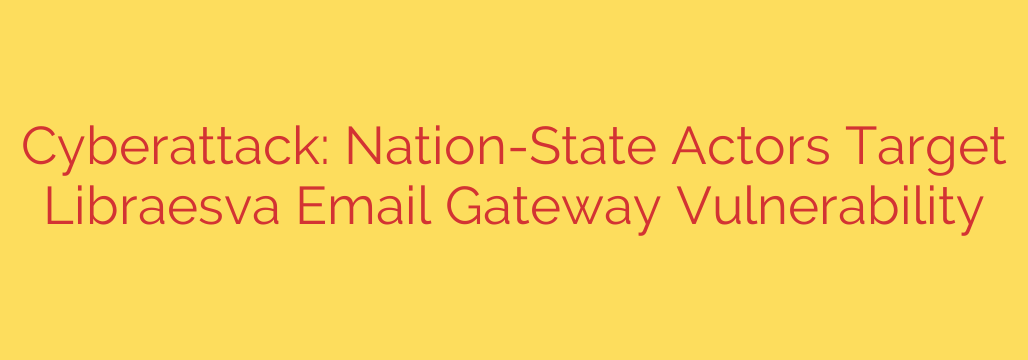
Critical Libraesva ESG Vulnerability Actively Exploited by Nation-State Hackers
A critical security flaw in the Libraesva Email Security Gateway (ESG) is being actively exploited in the wild by sophisticated, state-sponsored threat actors. The vulnerability allows for complete system takeover, providing attackers with a powerful foothold to infiltrate corporate networks, steal sensitive data, and move laterally across internal systems.
This high-severity incident underscores the critical importance of securing internet-facing appliances, which are prime targets for espionage and intelligence-gathering operations. Organizations using the Libraesva ESG platform must take immediate action to mitigate this threat.
The Vulnerability Explained: CVE-2023-4040
The core of the issue lies in a now-patched vulnerability tracked as CVE-2023-4040. This flaw is a critical-severity, unauthenticated remote code execution (RCE) vulnerability. In simple terms, this means an attacker can remotely execute malicious commands on a vulnerable Libraesva ESG appliance without needing any login credentials.
The vulnerability stems from a component in the web interface that fails to properly validate user-supplied data. By sending a specially crafted request, an attacker can trick the system into running arbitrary code with the highest level of privileges. This effectively hands over full control of the email gateway to the adversary.
The Attack Chain: From Gateway to Full Network Compromise
Security researchers have observed a clear and deliberate attack pattern deployed by the nation-state actors exploiting this flaw. The attack typically unfolds in several stages:
- Initial Compromise: The attackers first scan the internet for unpatched Libraesva ESG appliances. Once a target is identified, they exploit CVE-2023-4040 to gain initial access and establish a persistent backdoor on the email gateway.
- Credential Harvesting: With control over the gateway, the attackers deploy tools to harvest credentials. This includes dumping usernames and passwords stored on the device, often targeting credentials used for Active Directory or other internal services connected to the email system.
- Lateral Movement: Using the stolen credentials, the threat actors then pivot from the compromised email gateway into the wider corporate network. This lateral movement allows them to access other servers, workstations, and sensitive data repositories, significantly expanding the scope of the breach.
- Data Exfiltration and Espionage: The ultimate goal is often long-term espionage. Once embedded within the network, the attackers focus on identifying and exfiltrating valuable intellectual property, financial data, and other confidential information.
The involvement of nation-state actors indicates that these attacks are not random acts of cybercrime but targeted operations with specific intelligence-gathering objectives. These groups are well-resourced, patient, and highly skilled at covering their tracks.
How to Protect Your Organization: Immediate Steps to Take
Any organization utilizing the Libraesva Email Security Gateway is at risk. It is imperative to act decisively to secure your environment and investigate for potential compromise.
- Patch Immediately: The single most important action is to update your Libraesva ESG appliance to a patched version. The vendor has released security updates that fully address CVE-2023-4040. Delaying this update leaves your organization exposed.
- Hunt for Signs of Compromise: Even after patching, you must assume a breach may have already occurred. Security teams should thoroughly investigate appliance logs for any signs of suspicious activity. Look for unusual outbound connections, unexpected processes, or unauthorized configuration changes dating back several months.
- Rotate All Related Credentials: Due to the attackers’ focus on credential harvesting, it is critical to reset passwords for any service accounts or administrator credentials that were stored on or accessible from the ESG appliance. This includes Active Directory service accounts and administrative logins.
- Enhance Network Monitoring and Segmentation: Ensure that your email gateway is properly segmented from your internal network. Implement robust monitoring to detect and alert on any unusual traffic patterns originating from the gateway to other internal systems. This can help contain a breach and prevent lateral movement.
This incident is a stark reminder that email gateways are high-value targets for sophisticated attackers. Securing them requires not only timely patching but also a defense-in-depth strategy that includes robust monitoring, credential management, and network segmentation. Act now to patch your systems and thoroughly investigate for any signs of a breach.
Source: https://securityaffairs.com/182552/hacking/nation-state-hackers-exploit-libraesva-email-gateway-flaw.html








